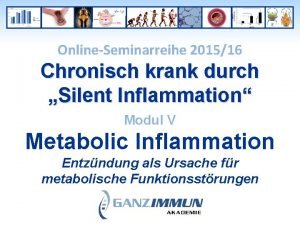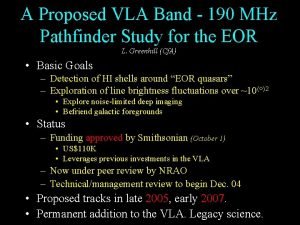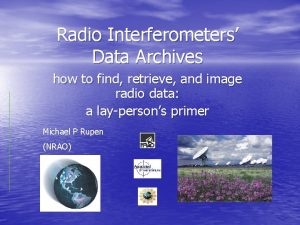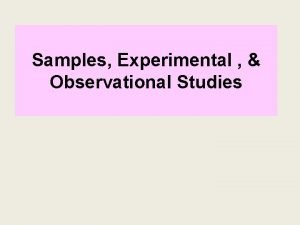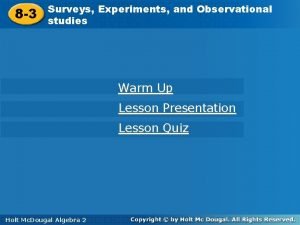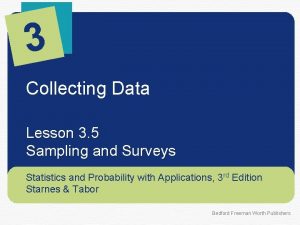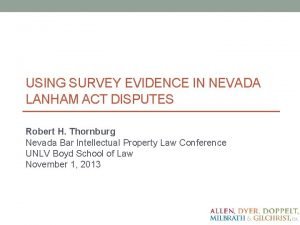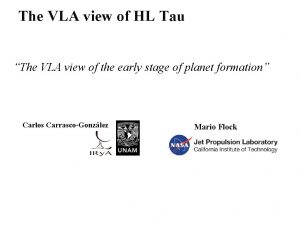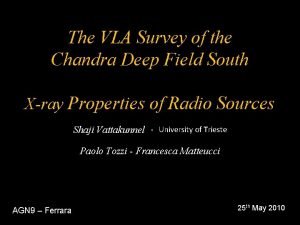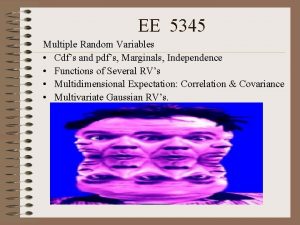Deep Surveys with the VLA The CDFS and














- Slides: 14

Deep Surveys with the VLA: The CDFS and UDF K. I. Kellermann, E. B. Fomalont (NRAO), E. Richards, J. Kelly (NRAO & UVa), Neal Miller, NRAO and Johns Hopkins R. Windhorst (Arizona) B. Partridge (Haverford) P. Shaver, P. Padovani, P. Rosati (ESO), P. Tozzi (INAF), V. Mainieri (MPE)

Deep VLA Surveys Field Θasec λcm σµJy N arcmin-2 Reference HDFVLA 1. 5 4 1. 8 0. 5 Richards et al. 1998, Ap. J 116, 1039 HDFVLA 1. 5 20 8 0. 6 Richards, 2000, Ap. J, 533, 611 HDFVLA+MERLIN 0. 2 20 3 0. 6 Muxlow et al. 2005, MN, 358, 1159 SSA 13 VLA 4 4 1. 5 0. 6 Fomalont et al. 2002, AJ, 123, 2402 SSA 13 VLA 1. 5 20 5 1. 5 Fomalont et al. 2006, Ap. JS, in press CDFS/UDFVLA 3. 5 20 8 0. 8 Unpublished CDFS/UDFVLA 3. 5 6 8 Unpublished

I = 18. 5 Z=0. 32 VLA-Merlin Observations of the HDFN HDFVLA EVN VLBI I=25. 5 I = 20. 7 Z = 0. 96 I = 21. 1 Z = 0. 47 I > 25 Z= 4. 42 I > 28. 5 I = 28 I-K~5 Z~4 I = 20. 9 I-K>4 Z=4. 4 Z = 1. 05

Chandra Deep Field South 942 ks exposure 361 X-ray sources 5 x 10 -17 ergs/sec Extended CDFS 250 ks per field Hubble UDF 976 ks exposure B, V, I, z 10, 000 galaxies I < 29 GOODS ACS B, V, i, z I < 28 VLA 20 cm

8 μJy 11 μJy 8 μJy

VLA Observations 6 and 20 cm θ = 3. 5 arcsec σ = 8 -11 μJy 266 Radio sources 198 Sources in Complete sample S 20 > 40 micro. Jy Within CDFS 57 in CDFS X-ray list 74 additional in ECDFS 1. 4 GHz (20 cm) New Observations @ 6 cm σ = 6 (4) μJy

Optical Counterparts More than 90% optical counterparts Ø A few classical radio galaxies I < 20 Ø Most radio sources have optical counterparts in the range 20 < I < 25 Ø l l Ø Typically red: (R - z) ~ 2 Some are very red (R-z) ~ 5 Galaxies with luminous starforming regions in interacting systems (groups or pairs) AGN s Optically quiet radio sources

VLA Observations 1. 4 GHz (20 cm)

S 20 = 1. 4 m. Jy S 6 = 0. 5 m. Jy α = - 0. 7 B>28. 0 I>27. 4 Z> 26. 9 H>25. 5 V >28. 1 J>26. 0 K>25. 5 4. 5 μ > 24. 0 8 μ > 24. 0

Radio/x-ray source properties 198 radio sources with S 20 > 40 μJy 57 sources have X-ray counterparts Soft (0. 5 -2 kev) band flux 3. 8 x 10 -17 ergs/s/cm 2 Hard (2 -10 kev) band flux 4. 6 x 10 -17 ergs/s/cm 2 Remaining 141 sources

Radio

AGN Star formation. Star AGN Radio formation • • AGN

Next Steps Ø Examine 20 cm image over a range of surface brightness Ø Analyze new 6 cm image including UDF Ø Obtain spectra (redshifts) for all radio sources ECDFS X-ray sources Ø Get deeper radio images at 6 and 20 cm http: //www. mpe. mpg. de/~mainieri/cdfs_pub/

• Comments Both weak X-ray and weak radio emission are increasingly due to star formation rather than AGN, but AGN are important at all levels. • Weak X-ray sources are mostly ordinary late type galaxies, while radio sources are a mixture of bright (AGN) and fainter (starforming) galaxies showing signs of mergers or interactions. • Many micro. Jy radio sources are identified with very red galaxies, possibly with submm excess. • About 10% of micro. Jy radio sources unidentified, some to very low levels in other wavebands • There is no missing population of low surface brightness micro. Jy radio sources • There are significant field to field variations (cosmic variance). HDF is low, CDFS is high. Sub milli. Jy differential count slope is -2. 4. • About 10% of radio sources displaced from nucleus • Natural confusion may limit the ultimate sensitivity of deep surveys
 übergewicht vla
übergewicht vla The vla band
The vla band Vla data archive
Vla data archive Ddcal
Ddcal Deep asleep deep asleep it lies
Deep asleep deep asleep it lies Deep forest towards an alternative to deep neural networks
Deep forest towards an alternative to deep neural networks 深哉深哉耶穌的愛
深哉深哉耶穌的愛 Observational study examples statistics
Observational study examples statistics What are surveys experiments or observations
What are surveys experiments or observations Lesson 3.5 what is wrong with these surveys
Lesson 3.5 what is wrong with these surveys Lanham act surveys
Lanham act surveys Snap survey software
Snap survey software Real eyes surveys
Real eyes surveys Survey rebuttals
Survey rebuttals Purpose of security survey and inspection
Purpose of security survey and inspection
